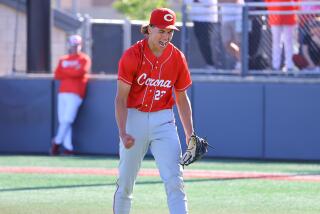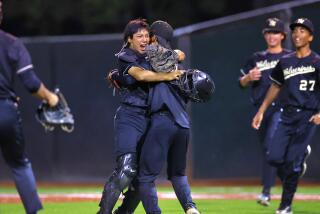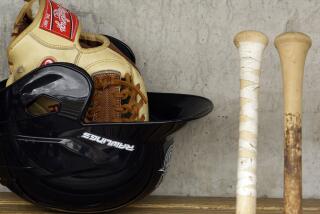HOME SWEET HOMER : Short Left-Field Fence at St. Bernard High’s Baseball Field Is Heady Temptation for Batters
- Share via
Phil Ruhl remembers the first time he stepped to the plate at St. Bernard High’s baseball field and fixed his eyes on the left-field fence that stands a mere 250 feet away.
Like countless other right-handed batters, Ruhl was consumed by one thought.
“I have to admit I tried to jack the ball out of the park,” he said. “I did exactly what all the other kids try to do.”
Ruhl, a junior first baseman for St. Bernard, has since learned to suppress the temptation that results from playing at a field where the dimensions are better suited for youth league baseball than high school competition.
Ruhl’s attitude is if he hits the ball well, the home runs will come.
“You have to adjust,” he said. “You have to realize that not every ball you hit is going to go out of here.”
Not every ball. Just a lot of them.
In 5 1/2 seasons under Coach Bob Yarnall, St. Bernard has hit 209 home runs in 146 games. The Vikings tied a Southern Section single-season record in 1988 with 51 home runs in 26 games, an average of nearly two per game.
St. Bernard is on a similar pace this season. Through 17 games, the Vikings (10-6-1) have 29 home runs, led by the 6-foot-1, 195-pound Ruhl with six.
The only other South Bay schools that come close to rivaling St. Bernard’s home run totals are El Segundo and Miraleste, which also play on small fields. El Segundo, which hit a school-record 47 home runs last season and 41 in 1987, plays at Recreation Park in El Segundo, where the odd dimensions are 335 feet to left, 320 to center and 310 to right.
“And St. Bernard’s (field) is much smaller than ours,” El Segundo Coach John Stevenson said. “There are no fly balls to left at St. Bernard. They’re home runs.”
Yarnall admits that a large portion of St. Bernard’s power-hitting success can be attributed to the cozy confines of its campus field. It is 300 feet to right field and 350 to center, with both power alleys very reachable.
South Torrance Coach Bob Grant didn’t realize how reachable the outfield fences were until his team played a nonleague game at St. Bernard last month. Although he grew up in the neighboring community of Westchester and was aware that St. Bernard had a small park, Grant said nothing prepared him for playing there.
St. Bernard beat South, 9-8, as the teams combined for six home runs, four by St. Bernard.
“I never realized how small the ballpark was until I played there,” said Grant, who was the L.A. City Section Player of the Year in 1975 as a catcher for Westchester High. “I didn’t realize it was that small down the line. You can run up some stats there.”
Yet, Yarnall points out that in five previous seasons, St. Bernard hit 40% of its home runs (74 of 180) away from home. This, he said, proves that his players are more than merely opportunists. They are good hitters.
This season, the Vikings have hit 12 of 29 home runs away from home.
“Yes, our park is small and we hit more home runs because of it,” Yarnall said. “But our record speaks for itself. There are other schools that play in parks just as small as ours and smaller that don’t have the home run record we do.
“We put some pretty good pop on the ball.”
Unlike past seasons, a large percentage of the lineup is getting into the act. Six Vikings have hit at least three home runs. After Ruhl, pitcher-third baseman Andy Diver has five and second baseman Sean Dunbar has four. Center fielder Larry Williams, shortstop-pitcher Grant Hohman and reserve Fernando Miranda have each hit three. Seven of the nine regular starters have at least two home runs.
“That’s the thing that surprises me,” Yarnall said. “It’s not just one or two guys. It seems that everybody is contributing.”
In the past, it was primarily one or two players who carried St. Bernard’s power-hitting torch. The most prolific was first baseman-pitcher Dan Melendez, who from 1987-89 hit 31 home runs, the second-highest career total in Southern Section history. (Scott Sharts of Simi Valley hit 32 from 1986-88).
Melendez, a Pepperdine sophomore in his second year as the Waves’ starting first baseman, hit 14 homers in each of his last two seasons at St. Bernard.
Other ex-Vikings who distinguished themselves include outfielder-pitcher Tim Williams, a senior outfielder for Loyola Marymount who hit 24 home runs from 1985-87, including a school-record 15 as a senior; and shortstop Royce Clayton, who hit 10 home runs in his senior year in 1988. Clayton was drafted in the first round out of St. Bernard by the San Francisco Giants and is now playing for the Giants’ double-A team in Shreveport, La.
It should be noted that Melendez and Williams, St. Bernard’s two greatest home run hitters, are left-handed batters and hit most of their home runs to right and center fields, not to the short porch in left.
“When they hit the ball, they crunched the ball,” Yarnall said. “They didn’t get any cheap home runs.”
Stevenson and Grant agreed that you can’t use the small dimensions of St. Bernard’s field to discount the accomplishments of the Vikings’ top players.
“Melendez is a class player who has proven himself way beyond St. Bernard,” Stevenson said. “He played on the junior national team and started as a freshman at Pepperdine. And Royce Clayton is one of the top 25 prospects in professional baseball.”
Nevertheless, St. Bernard’s players are sometimes subjected to ridicule by others because of the school’s short fences.
“I’ve had quite a few people tell me that the only reason I have this many home runs is because we play in a small park and the wind blows out,” Ruhl said. “I try to ignore that and just concentrate on my game.”
Ruhl said the key to hitting successfully at St. Bernard is to forget about the short fences and concentrate on making good contact.
“A lot of big kids come in here and try to jack the ball out of the park,” he said. “But it’s sometimes the little guys who are more successful. I think that’s because they’re not thinking about hitting the long ball as much. They’re just trying to get a bat on the ball.”
Yarnall said the temptation to hit home runs sometimes works against his team, especially when they play in bigger parks.
“People might think we have an advantage playing here, but it tends to go against us if we go away and play at a big park,” he said. “It’s too hard to get these kids to change their swings. I try to teach them to hit line drives up the middle, but it’s hard to get someone to change their stroke.”
Another downside of playing on a small field is the negative impact it has on pitchers. What would be a routine fly ball in most parks can easily become a home run at St. Bernard, especially if it’s hit to left.
As a result, Yarnall said Viking pitchers generally have higher earned-run averages than pitchers for other successful teams.
Yarnall said there has been talk of St. Bernard building a larger stadium on a vacant lot that extends beyond the left-field fence, across the street from the school.
Until then, look for the Vikings to keep racking up impressive home run totals and for Yarnall to keep recycling the same line at league meetings.
“We kind of make a joke about it,” he said. “We tell the other coaches to make sure their kids pull the ball and upper cut.”
HOME RUN HAVEN
St. Bernard High’s year-by-year home runs for teams coached by Bob Yarnall.
Year HRs Record 1986 25 18-6 1987 34 20-6 1988 51* 21-5 1989 33 20-6 1990 37 20-7 1991+ 29 10-6-1
* Tied for Southern Section record
+ Season not complete
More to Read
Get our high school sports newsletter
Prep Rally is devoted to the SoCal high school sports experience, bringing you scores, stories and a behind-the-scenes look at what makes prep sports so popular.
You may occasionally receive promotional content from the Los Angeles Times.






